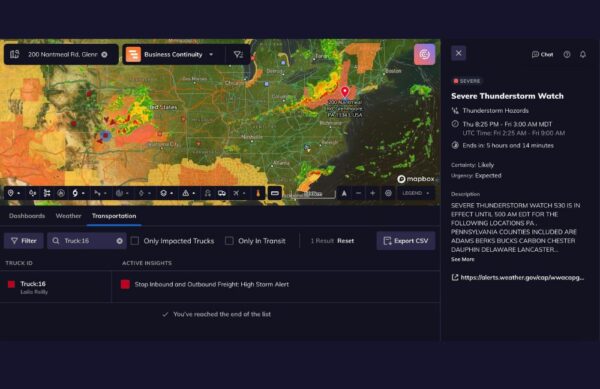Governance: Safety Management System
Improve safety performance by implementing safety management systems that help reduce weather-related workplace injuries. Adhere to standardized policies and procedures set by federal organizations such as the FAA or USDL.
U.S. companies pay $62 billion each year for workplace injuries. Studies show that for every $1 invested in an injury prevention program, up to $6 is returned.
Insight In this Dashboard
severity - 4 extreme
Cancel Loads: Extremely Low Visibility
Do not let drivers head out on the roads while visibility is this low. Under the given conditions, driving is very dangerous and puts excess stress on the driver.
severity - 4 extreme
Enforce Breaks During Hours of Service: High Temp
Ensure drivers are stopping enough times during hours of service on the road. Plan accordingly and be flexible with arrival time to the destination so that it considers drivers' recovery and break schedules.
severity - 3 sever
Keep Employees Inside: Bad Air Quality
Postpone outdoor activity for a later time, unhealthy air quality will make working conditions dangerous. Ensure that facilities are well ventilated.
severity - 3 sever
Provide Extra Water: High Humidity
Ensure all employees have enough water to keep them hydrated throughout hours of service.
severity - 3 sever
Provide Protective Gear: Poor Air Quality
Ensure any employees working outside have proper personal protective equipment such as gloves, eye and face coverings.
severity - 2 moderate
Set Up Floor Mats Inside: Wet Conditions
Set up floor mats for employees to dry off shoes before entering the indoor facility. Avoid letting any rain water build-up inside that could cause people to fall.
severity - 3 sever
Work Rest Cycle 1
For every 120 minutes of work in this heat, schedule a 5-minute break so that employees can recover and avoid heat exhaustion. Establish a break schedule so that employees performing physical work have adequate time to rest and avoid fatigue which could result in an accident.
severity - 4 extreme
Temporarily Halt Operations: Heat Threshold Exceeded
Temperatures are exceeding state regulations for working outdoors. Provide employees with shade, water, and adequate time to rest.
severity - 3 sever
Work Rest Cycle 2
For every 90 minutes of work in this heat, schedule a 10-minute break so that employees can recover and avoid heat exhaustion. Establish a break schedule so that employees performing physical work have adequate time to rest and avoid fatigue which could result in an accident.
severity - 3 sever
Work Rest Cycle 3
For every 60 minutes of work in this heat, schedule a 15-minute break so that employees can recover and avoid heat exhaustion. Establish a break schedule so that employees performing physical work have adequate time to rest and avoid fatigue which could result in an accident.
severity - 4 extreme
Monitor Conditions: Flood Risk
Prep teams and avoid any unnecessary outdoor work. Flash flooding is possible.
severity - 4 extreme
Monitor Conditions: Lightning Risk
Prep teams and avoid any unnecessary outdoor work. High risk for lightning in the area.

